City trip Salzburg
Baroque buildings and a medieval fortress high up a hill
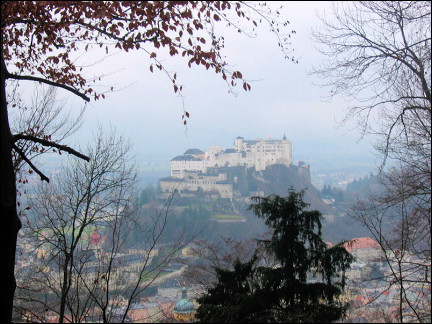
|
Salzburg has an exquisite city center dominated by baroque buildings and the fortress Hohensalzburg, high up a hill. The city center is on the Unesco World Heritage list. Mozart's town of birth on the banks of the Salzach river is (with its 150.000 inhabitants) not a big city, but has enough to offer for a few days' visit.
Travelogue & photos: Luk Carion
Flying from Charleroi, Belgium, it takes us an hour to arrive at Salzburg's W.A. Mozart Airport. In Mozart's time, traveling to Brussels, Paris, London and Amsterdam - to name some of the places the composer visited - was a completely different experience. Horse coaches took months, traveling on bumpy and muddy roads and through huge and dark forests.
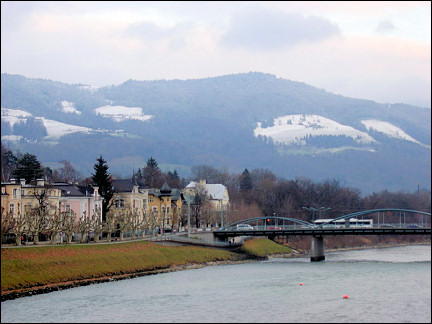
|
Salzburg is divided in two halves by the Salzach river: the Altstadt (old city) and the Neustadt (new city). The city is hemmed in between two hills, the Kapuzinerberg and the Mönchsberg.
In two days we try to visit the most important sights. We succeed, but the days are filled to the rim and our legs feel the many kilometers and stairs they climbed.
Neustadt
Medieval streets with tall houses
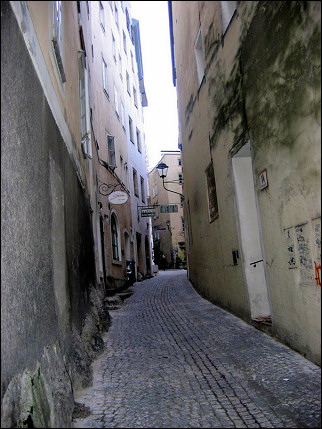
|
We begin our walk at the Staatbrücke, a bridge over the Salzach which connects the old and the new (which should not be taken litterally here)parts of town. In the distance we see the Alps, the first snow has fallen on the pastures. On the banks of the Salzach are wonderful boulevards with chestnut trees.
We walk in the Steingasse: the gables of the tall houses are typical for a Salzburg street with medieval and baroque townhouses. The frivolous Mozart is likely to have spent time here: this narrow alley was part of the city's red light district. Except for one building, nothing remains that reminds of this.
We climb a lot of stairs to the top of the Kapuzinerberg. Part of the 17th century city walls are visible here. We have a great view of the Altstadt on the other side, with its church towers and domes and on the Mönschberg the Festung Hohensalzburg (an ancient fortress).
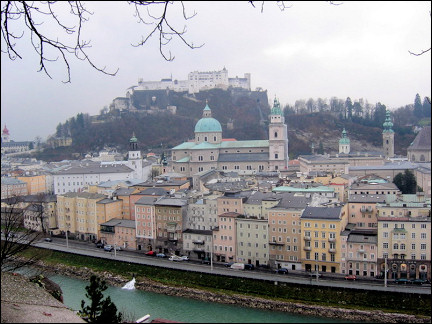
|
A little farther is a bust of Mozart: it memorializes that on this spot on the edge of the forest was the log cabin where the then already terminally ill Mozart composed "Die Zauberfloete" (The Magic Flute).
We continue to climb the wooded hill, we pass the Kapuzinerkloster (the ornate oak doors of the old Roman cathedral were used here) and eventually, after 263 steps, we arrive at the Franziscischlössen, a 17th century accomodation for the city wall guards.
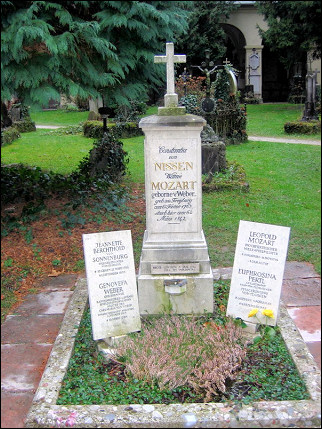
|
We descend in the direction of the Linzergasse, on our way passing by baroque Stations of the Cross. The Linzergasse is an elegant shopping street on which you'll also find the St. Sebastianskirche.
The italianate cemetary is worth visiting. It is surrounded by 84 baroque arches and has a mausoleum at its center. On our way there we pass by the graves of Mozart's father Leopold and Mozart's wife Constanze. Mozart himself was buried in an unmarked grave. The austerity and simplicity of the cemetary, its location between the natural surroundings of the Kapuzinerberg and the lively city center leave a deep impression.
Mirabellschloss
The orderly 18th century garden is a haven of quiet
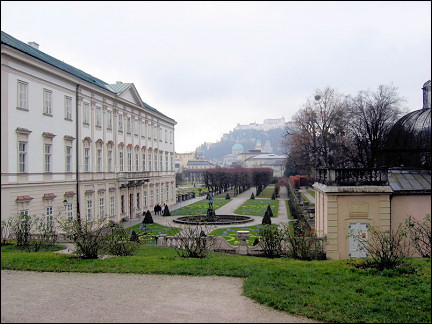
|
Via the Paris-Lodronstrasse we walk to the Mirabellplatz. The castle itself dates from 1606 and was commissioned to be built near the city walls by archbishop Wolf Dietrich for his mistress Salome Alt with whom the clerical authority had 15 children. The castle was called Altenau in those days.
The castle was renovated in the early 18th century, but almost completely burned down in 1818. Eventually the castle was rebuild in classicist style.
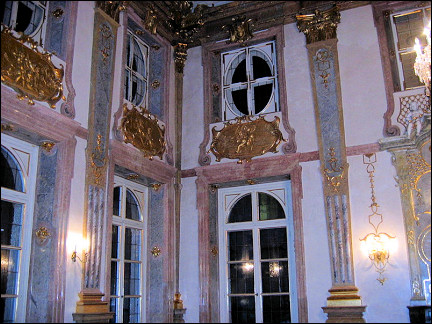
|
The marble hall is according to many people the most beautiful wedding hall in the world; it is often used as a concert hall as well. The rest of the buildings are currently in use by the city, among others they house the city library.
The orderly 18th century Mirabell garden is a haven of quiet in the city: fountains (unfortunately they are covered during the winter to protect them from frost), lots of flowers during the summer (now hundreds of pansies) and trimmed hedges.
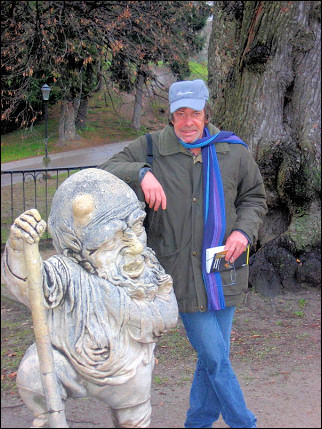
|
The dwarf garden with 13 sculptures of freaks is a surprise. The rose garden has a great view of almost the whole garden, the castle, the Altstadt with its many domes and in the distance, on the horizon, the Mönschberg with the Festung Hohensalzburg (the ancient fortress).
We stroll on to the Makartplatz: pretty buildings from the Habsburgs Empire are the post office and hotel Bristol. The square itself is dominated by the Dreifaltigkeitskirche (Trinity Church) which was built around 1700.
Mozart's residence is nearby. The family lived here - between tours - from 1773 to 1787. Their large apartment was on the second floor. The building has been renovated completely.
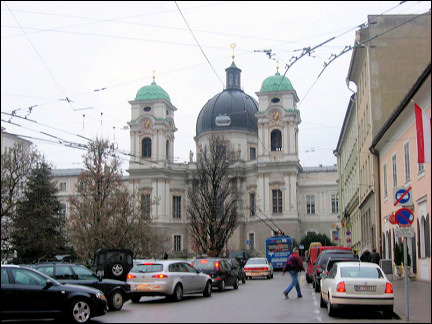
|
Don't expect any objects that were owned by Mozart or his family, they were unfortunately all lost. There is an introduction to his work (audio guide) and there are musical instruments from his era: harpsichord, piano and organ.
Altstadt
Richly decorated signs and elegant porches
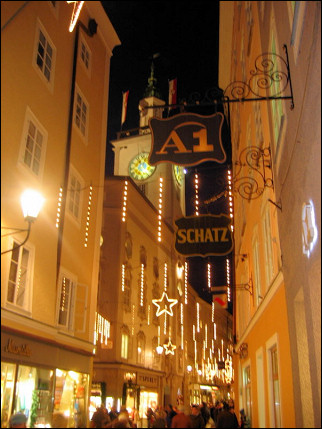
|
We walk by the Landestheater and the Mozarteum (the Mozart archives), cross the Salzach into the Altstadt where we continue our route on the left bank, downriver, along the Rudolfskai, a beautiful boulevard with chestnut trees. It's a delightful walk with a view of the Kapuzinerberg. The Salzach rustles and a little farther tour boats are docked until the summerseason begins.
We trot on to the Müllnerkirche and turn there to visit the nearby Haus der Natur (science museum). Its collection of coral fish and live coral is famous. We stay there a long time, too long to be able to visit Mozart's house of birth.
We walk to the center of the Altstadt via the Getreidegasse: it is the only crowded part of Salzburg. This street is one of Austria's nicest shopping centers, which also has kept its authenticity. For a long period of time it was the only throughstreet in the Altstadt.
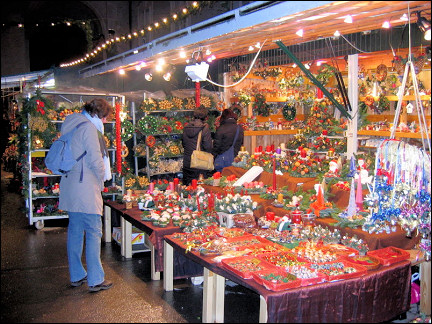
|
Richly decorated signs, elegant porches and beautiful gables are the backdrop of this dazzling alley. Every sign is a piece of art and all together they form a fascinating unity.
Also famous are the "through-buildings." The Getreidegasse doesn't have one single cross-street, so for a long time these buildings were the only way to get to the Salzach. It's getting dark already, so the X-mas decorations are accentuated. Every square has its own X-mas market with wooden stalls; you won't believe what's for sale here.
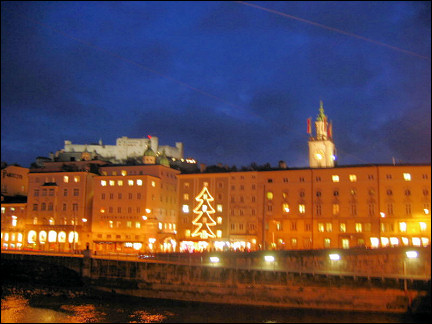
|
In front of the cathedral a men's choir sings solemn christmas carrols. A little farther a brass band plays beautiful and atmospheric christmas music. Little by little we get immersed in christmas atmosphere.
Hohensalzburg Festung
The largest remaining complete fortress
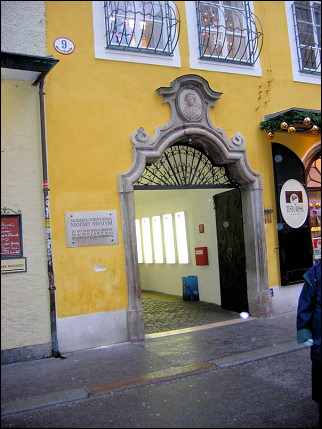
|
After a good night's sleep (our hotel is in a quiet street in the center of the Altstadt), we hit the streets again, first we're going to visit Mozart's house of birth in the Getreidegasse.
Mozart was born here on January 27, 1756 and the family lived here until 1773. Today it houses the interesting Mozart museum.
Interesting exhibits are a violin Mozart played as a child, his concert violin, harpsichord and piano, as well as several manuscripts and portraits.
We look for the cable tram which will take us to the Hohensalzburg Festung, a fortification and the largest remaining complete citadel of Central Europe, the symbol of the Mozart city. It sits at 120 meters above the Salzach river and offers a great view of the city and the surrounding mountains.
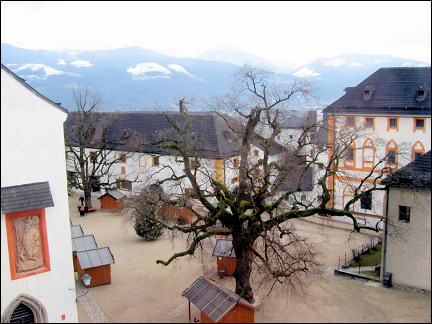
|
The citadel dates from 1077 (when it was a wooden structure). The surviving buildings were built around 1500. Nowadays they house a museum and private apartments. It is a gigantic complex with everything a city has: church, workhouse, dining hall, towers with living quarters, etc.
On the citadel courtyard we see a rain barrel with bars and a centuries-old linden tree. We take a tour of the Hohe Stocke (upper floor), the main building of the citadel.
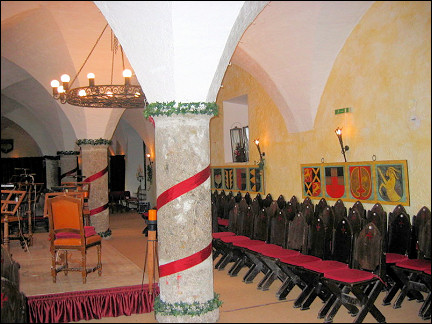
|
We see the oldest still usable organ in the world, with 200 tin pipes; the torture room, the royal room. When we reach the top of the tower, Salzburg lies at our feet. Take half a day to visit this citadel.
Residenz
Austere front hides pomp and circumstance
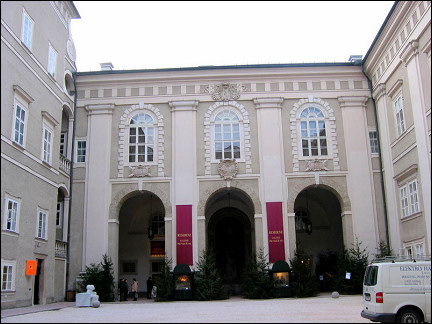
|
We visit the Residenz which in its current state dates from the 17th century and was inhabited until 1803 by consecutive Salzburger archbishops. The austere front doesn't prepare us for the pomp and circumstance we'll see inside, in the knights hall, conference room, audience hall and private quarters.
The walls are decorated with Flemish tapestries, the ceilings are painted with all kinds of designs. Here Mozart played his first compositions as a 6 years-old. There are beautiful masonry stoves which are operated from alcoves outside the rooms, so the bishop wouldn't be disturbed.
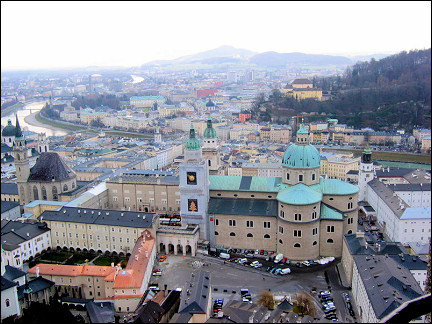
|
On the next floor now is the Residenzgalerie, a museum with many, mainly 19th century, paintings. Dutch art is well represented with among others a painting by Rembrandt.
Cathedral and St Peter Stifskirche
Roman and rococo shake hands
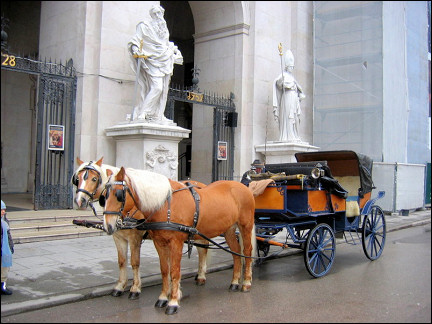
|
The cathedral (built 1614-1665) dominates Salzburg. It was the first monumental baroque church north of the Alps, the St Peter of the Austrian Rome. It seats 10,000 people. Two tall towers rise up from the marble front; in the back is a huge dome.
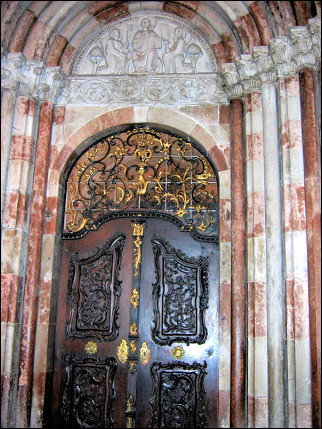
|
In the front porch are statues of saints: Peter, Paul, Vergil and Rupert. After we pass through the dark nave, we arrive in the light hall with the enormous dome, which has three main altars. Impressive but pompous, that's how we feel about it. In front of the cathedral horse coaches are waiting for tourists who want to take a ride.
Much prettier than the cathedral is the St Peter Stifskirche: two extremes, roman and rococo, shake hands here. The roman porch has the scrolls and leafgold of the rococo door. A gorgeous cast-iron fence guards the entrance. The roman interior is covered with frescoes and paintings.
To the right of this beautiful church is the cemetary with the graves of Haydn and Mozart's sister. We take a stroll here and then look for a restaurant to have dinner.
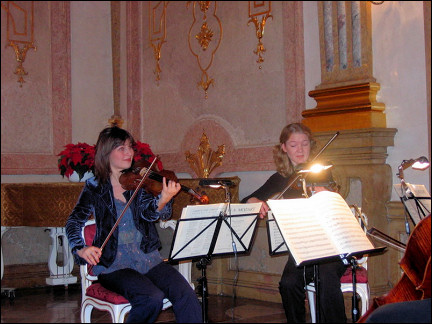
|
It's a little early for dinner, but later we'll attend a concert in the Marble Hall of the Mirabellschloss. We hear beautiful music by Mozart and also a piece by Schubert. What could be a better conclusion of our trip?